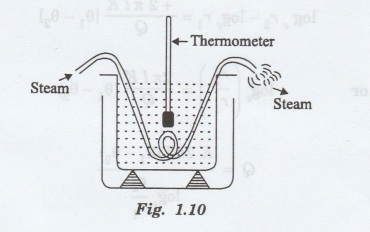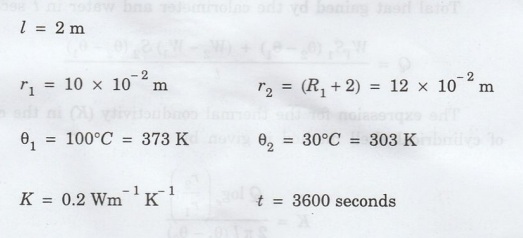Physics For Civil Engineering: Unit I: Thermal Application
Thermal Conductivity of Rubber
Principle, Procedure, Observation, Formula, Solution
A big empty calorimeter with stirrer is weighed (W1). It is then filled with two-thirds of water and again weighed (W2). A known length (l) of a rubber tube is immersed in water in the calorimeter
THERMAL CONDUCTIVITY OF RUBBER
Principle
It
is based on the principle of radial flow of heat through a cylindrical shell.
Procedure
A big empty calorimeter with stirrer is
weighed (W1). It is then filled with two-thirds of water and again
weighed (W2). A known length (l) of a rubber tube is immersed in
water in the calorimeter (fig. 1.10).
The calorimeter is stirred well and the
initial temperature θ1°C is noted.
Now one end of the rubber tube is
connected to a steam generator and steam is passed through it.
The steam is passed continuously till
there is a rise of 10°C in temperature. The time taken (t second) for this rise
in final temperature of the water (θ2°C)
in the calorimeter is also noted.

Observation
Mass of the empty calorimeter with
stirrer = W1 kg
Mass of the calorimeter + water = W2
kg
Mass of the water = (W2- W1)
kg
Initial temperature of the water = θ1°C
Final temperature of the water = θ2°C
Rise in the temperature of water = (θ2
- θ1)
Time for which steam is passed = t
second
Length of the rubber tube immersed in
water = l
Inner radius of the rubber tube = r1
Outer radius of the rubber tube = r2
Specific heat capacity of calorimeter =
S1
Specific heat capacity of water = S2
Heat gained by the calorimeter = Mass × specific heat capacity × change in temperature
= W1 × X S1× (θ2-θ1)
………………....(1)
Heat gained by the water = (W2- W1) × S2
× (θ2-θ1) ……………....(2)
Total heat gained by the calorimeter and
water in t second

The expression for the thermal
conductivity (K) in the case of cylindrical shell method is given by

substituting eqn (3) in eqn (4), we have

where θs temperature of steam
θ1 + θ2/ 2 -Average
temperature inside of rubber tube.
Problem 1.5
2demiolo lo viosqes ised oftiosq A metal pipe having an external diameter 20 cm carries steam at 100°C. This is covered by a layer 2.0 cm thick of insulating material with co-efficient of thermal conductivity 0.20 Wm-1 K-1. If the outer surface is 30°C, calculate the heat lost by the pipe of 2m length per hour. Neglect the temperature drop across the pipe. (A.U. Nov. 2019)
Given
data:

Solution:
Formula:
Quantity of heat flowing out
across the pipe of length 'l' m in time 't' seconds

∴ The quantity of heat lost by the pipe per hour Q = Q = 3.472 × 106 Joules
Physics For Civil Engineering: Unit I: Thermal Application : Tag: : Principle, Procedure, Observation, Formula, Solution - Thermal Conductivity of Rubber
Related Topics
Related Subjects
Physics for Civil Engineering
PH3201 2021 Regulation | 2nd Semester Civil Dept 2021 Regulation
